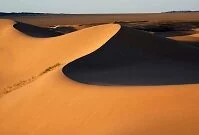Weather

Gobi Desert
Summers in Mongolia can be very rainy in the north, but temperatures peak during this time. Ulaanbaatar boasts daily highs of about 72°F (22-23°C) during the summer, but night temperatures still drop to only about 50°F (10°C). This season allows easy travel options as the roads are cleared of snow and transportation options tend to fall as there are little obstacles to travel. Winters are the opposite extreme with highs of only 5-15°F (-10 to -15°C), but still fairly sunny most days; unfortunately, this season makes transportation nearly impossible with snow closing many roads and a trip to a nomadic village off the travel itinerary. Falls (autumn) can be cold and receive snow, while springs seem pre-occupied with nomads busy tending to their animals as many roads are not cleared of snow, the plains are windy, and temperatures are still cold.
Wildlife
Mongolia's weather and landscape dictate the animals that can survive and thrive so the variety is somewhat limited, but still fairly diverse. Among the mammals, the marmot, fox, rabbit, wolves, and squirrel are among the most common. There are dozens more though, including less common lynx, bears, antelope, leopards, and gazelles. The sea life is limited due to the lack of water borders, but also due to the Gobi Desert. There are still numerous small fresh water fish and shellfish in the rivers, streams, and lakes though, including trout, salmon, sturgeon, carp, and pike.
Where Mongolia flourishes is in its bird life. Although some birds call the country home, many more migrate through each year. These birds include eagles, vultures, flacons, cranes, larks, swans, geese, pelicans, and gulls. Among the reptiles, are mostly lizards and there are a few amphibian species that exist as well, although in smaller numbers, like frogs. There a thousands of insect species though.